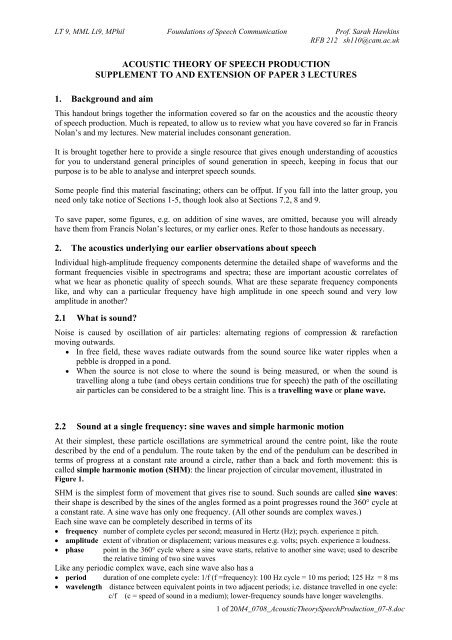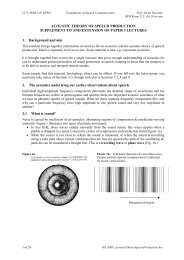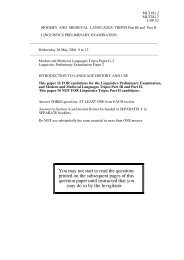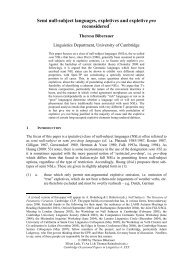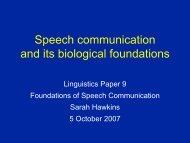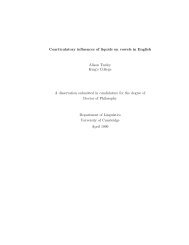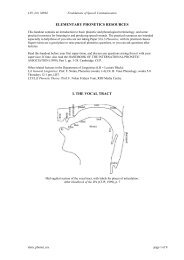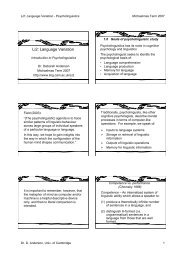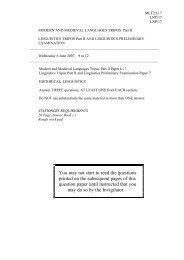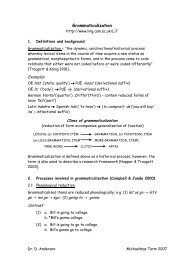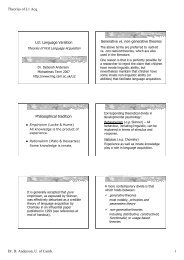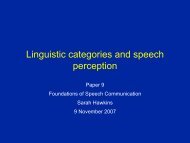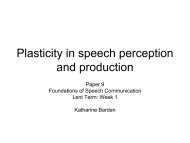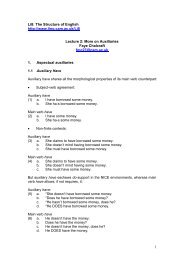ACOUSTIC THEORY OF SPEECH PRODUCTION ... - Ling.cam.ac.uk
ACOUSTIC THEORY OF SPEECH PRODUCTION ... - Ling.cam.ac.uk
ACOUSTIC THEORY OF SPEECH PRODUCTION ... - Ling.cam.ac.uk
Create successful ePaper yourself
Turn your PDF publications into a flip-book with our unique Google optimized e-Paper software.
LT 9, MML Li9, MPhil Foundations of Speech Communication Prof. Sarah Hawkins<br />
RFB 212 sh110@<strong>cam</strong>.<strong>ac</strong>.<strong>uk</strong><br />
<strong>ACOUSTIC</strong> <strong>THEORY</strong> <strong>OF</strong> <strong>SPEECH</strong> <strong>PRODUCTION</strong><br />
SUPPLEMENT TO AND EXTENSION <strong>OF</strong> PAPER 3 LECTURES<br />
1. B<strong>ac</strong>kground and aim<br />
This handout brings together the information covered so far on the <strong>ac</strong>oustics and the <strong>ac</strong>oustic theory<br />
of speech production. Much is repeated, to allow us to review what you have covered so far in Francis<br />
Nolan’s and my lectures. New material includes consonant generation.<br />
It is brought together here to provide a single resource that gives enough understanding of <strong>ac</strong>oustics<br />
for you to understand general principles of sound generation in speech, keeping in focus that our<br />
purpose is to be able to analyse and interpret speech sounds.<br />
Some people find this material fascinating; others can be offput. If you fall into the latter group, you<br />
need only take notice of Sections 1-5, though look also at Sections 7.2, 8 and 9.<br />
To save paper, some figures, e.g. on addition of sine waves, are omitted, because you will already<br />
have them from Francis Nolan’s lectures, or my earlier ones. Refer to those handouts as necessary.<br />
2. The <strong>ac</strong>oustics underlying our earlier observations about speech<br />
Individual high-amplitude frequency components determine the detailed shape of waveforms and the<br />
formant frequencies visible in spectrograms and spectra; these are important <strong>ac</strong>oustic correlates of<br />
what we hear as phonetic quality of speech sounds. What are these separate frequency components<br />
like, and why can a particular frequency have high amplitude in one speech sound and very low<br />
amplitude in another?<br />
2.1 What is sound?<br />
Noise is caused by oscillation of air particles: alternating regions of compression & raref<strong>ac</strong>tion<br />
moving outwards.<br />
• In free field, these waves radiate outwards from the sound source like water ripples when a<br />
pebble is dropped in a pond.<br />
• When the source is not close to where the sound is being measured, or when the sound is<br />
travelling along a tube (and obeys certain conditions true for speech) the path of the oscillating<br />
air particles can be considered to be a straight line. This is a travelling wave or plane wave.<br />
2.2 Sound at a single frequency: sine waves and simple harmonic motion<br />
At their simplest, these particle oscillations are symmetrical around the centre point, like the route<br />
described by the end of a pendulum. The route taken by the end of the pendulum can be described in<br />
terms of progress at a constant rate around a circle, rather than a b<strong>ac</strong>k and forth movement: this is<br />
called simple harmonic motion (SHM): the linear projection of circular movement, illustrated in<br />
Figure 1.<br />
SHM is the simplest form of movement that gives rise to sound. Such sounds are called sine waves:<br />
their shape is described by the sines of the angles formed as a point progresses round the 360° cycle at<br />
a constant rate. A sine wave has only one frequency. (All other sounds are complex waves.)<br />
E<strong>ac</strong>h sine wave can be completely described in terms of its<br />
• frequency number of complete cycles per second; measured in Hertz (Hz); psych. experience ≅ pitch.<br />
• amplitude extent of vibration or displ<strong>ac</strong>ement; various measures e.g. volts; psych. experience ≅ loudness.<br />
• phase point in the 360° cycle where a sine wave starts, relative to another sine wave; used to describe<br />
the relative timing of two sine waves<br />
Like any periodic complex wave, e<strong>ac</strong>h sine wave also has a<br />
• period duration of one complete cycle: 1/f (f =frequency): 100 Hz cycle = 10 ms period; 125 Hz = 8 ms<br />
• wavelength distance between equivalent points in two adj<strong>ac</strong>ent periods; i.e. distance travelled in one cycle:<br />
c/f (c = speed of sound in a medium); lower-frequency sounds have longer wavelengths.<br />
1 of 20M4_0708_AcousticTheorySpeechProduction_07-8.doc
2 of 20 Paper 9 etc: AcThSpProd<br />
Figure 2. sinusoidal oscillation of air particles can be described in different ways, as:<br />
• displ<strong>ac</strong>ement<br />
• velocity<br />
• <strong>ac</strong>celeration<br />
• instantaneous sound pressure<br />
Acceleration leads velocity by 90°; velocity leads displ<strong>ac</strong>ement by 90°.<br />
When the particle is close to the source, displ<strong>ac</strong>ement is in phase (0°) with the source.<br />
For a plane wave which has no reflections, instantaneous sound pressure is in phase with particle<br />
velocity.<br />
When the sound is in a resonator such as a tube, there are reflections from the ends of the tube, and<br />
then velocity and pressure are out of phase. This is important in creating formant, or resonant<br />
frequencies, as we see later.<br />
Figure 3.<br />
The spectrum of a sine wave thus has a single frequency component (of a particular amplitude).<br />
amp<br />
amp<br />
freq<br />
freq<br />
Assuming the axes are on the same scale, the right hand spectrum shows a sine wave with about twice<br />
the frequency and two-thirds the amplitude of that in the left hand spectrum.<br />
2.3 Combining sine waves by adding them together<br />
When sine waves are combined, the resultant wave can be calculated simply by adding the amplitudes<br />
of the two waves at enough points in time to allow the new waveform to be plotted.<br />
Figure 4. When all component sine waves have the same frequency, another sine wave results, usually with a<br />
different amplitude and phase. The frequency remains the same.<br />
Or silence….when the two waves have identical amplitudes and frequencies but are 180° out of phase.<br />
Figure 5. When the sine waves to be added together have different frequencies, the result is a complex wave:<br />
that is, e<strong>ac</strong>h frequency is preserved in the resultant wave. The waveshape of this complex wave<br />
depends on the relative frequency, amplitude and phase of e<strong>ac</strong>h component sine wave.<br />
2.4 Making periodic and aperiodic complex waves<br />
When the component frequencies are related such that higher frequencies are integer (whole-number)<br />
multiples of the lowest one, then the complex waveform is periodic, and we hear a pitch.<br />
E<strong>ac</strong>h component frequency is called a harmonic. The lowest is H1; next is H2 = 2 (H1). H3 = 3 (H1).<br />
The highest common f<strong>ac</strong>tor of the harmonics (normally, the lowest frequency) is the fundamental<br />
frequency (f0, = H1). It is f0 that determines the period of the complex waves.<br />
Under most conditions, the perceived pitch is directly related to the fundamental frequency.<br />
The f0 does not have to be physically present in a periodic complex wave in order for us to hear its<br />
pitch.<br />
This has interesting implications for hearing, and how the ear/brain processes sound to hear pitch. But<br />
for speech, f0 is always the lowest frequency component of the periodic glottal waveform.<br />
M4_0708_AcousticTheorySpeechProduction_07-8.doc
Paper 9 etc: M4_AcThSpProd 3 of 20<br />
Harmonic components in three different (periodic) complex waves, two with f0 = 100 Hz, one with f0<br />
= 200 Hz.<br />
Component frequencies (Hz)<br />
H7 700 1400 700<br />
H6 600 1200<br />
H5 500 1000 500<br />
H4 400 800 400<br />
H3 300 600 300<br />
H2 200 400 200<br />
H1 (f0) 100 200<br />
Amplitude and phase changes in the components of a complex wave affect its shape but not its period<br />
i.e. not its fundamental frequency.<br />
Most complex waves in the natural world contain many frequencies that are not mathematically<br />
related in any way. Such random combinations of frequencies produce aperiodic waveforms, with no<br />
regularly repeating pattern in the waveshape (thus no period) and no true pitch.<br />
The dft spectra of Figures 2 and 3 in handout Introduction to Spectral Analysis (Lab 2) show the f0<br />
and the harmonic frequencies of the vowels they are taken from. We will explore this further in lab<br />
classes.<br />
If we were to plot the spectrum of an aperiodic speech waveform, there would be no harmonic<br />
frequencies, and we would normally plot only the spectral envelope.<br />
3. The basics of resonance<br />
Why can a particular frequency have high amplitude in one speech sound and very low amplitude in<br />
another?<br />
It is because the complex wave travels through a tube (the vocal tr<strong>ac</strong>t), which <strong>ac</strong>ts as a resonator.<br />
Resonance can be defined as vibration of an object at its natural frequency (or frequencies) in<br />
response to the same or similar frequencies applied by a driving force (either transient (impulse) or<br />
continuous). If the input is sound, frequencies in that sound that are close to the resonance frequencies<br />
of the object will be amplified, because it takes least energy to move the air particles at those<br />
frequencies i.e. large output for a small input of energy.<br />
You can check out this claim by singing different notes into a bottle or a tube. Certain pitches will<br />
sound louder than others, and when they sound loud, you will feel the bottle vibrating: it is resonating<br />
in sympathy with the excitation from your voice. Tubes and bottles of different lengths and shapes<br />
resonate at different frequencies, and a resonator’s natural frequencies can be calculated <strong>ac</strong>cording to<br />
well-understood principles.<br />
Likewise, as the vocal tr<strong>ac</strong>t changes shape, or the sound source changes from the glottis to somewhere<br />
in the oral cavity, then the resonance or formant frequencies change.<br />
Figure 6.<br />
Objects vary in what frequencies they respond to, and how strongly they respond.<br />
BANDWIDTH: the frequency range of an object’s response<br />
DAMPING: how quickly its response dies away after excitation by a single impulse.<br />
When the input is an impluse:<br />
narrow-bandwith response — lightly damped (e.g. tuning fork); high amplitude; response rings on<br />
wide-bandwidth response — heavily damped (e.g. table); low amplitude; short response<br />
M4_0708_AcousticTheorySpeechProduction_07-8.doc
4 of 20 Paper 9 etc: AcThSpProd<br />
INTERIM SUMMARY: THE BASICS<br />
Sound is either periodic the same pattern repeats more or less regularly: phonated sounds like [i u].<br />
or aperiodic there is no regularly repeating pattern: voiceless sounds lie [s].<br />
A sine wave is periodic but has only one frequency.<br />
A complex wave has two or more frequencies. All speech sounds are complex, and all have many<br />
frequencies.<br />
If a complex wave is periodic, then its components are harmonics.<br />
(If there are a few nonharmonic frequencies (enharmonic partials) amongs the harmonic partials, then<br />
the signal is almost periodic, or quasi-periodic.)<br />
TYPES <strong>OF</strong> COMPLEX WAVE<br />
Periodic<br />
Definition Regularly repeating waveform i.e.<br />
repeated cycles of the same shape.<br />
Aperiodic<br />
Irregular waveform; i.e. no cyclic<br />
repetition.<br />
Properties<br />
In speech<br />
The waveform comprises a fundamental<br />
frequency (f0) and harmonic frequencies<br />
(nf0). The harmonics are integer<br />
multiples of the f0. Thus f0 is the slowest<br />
component, and also the highest<br />
common denominator of the harmonics.<br />
We hear a pitch.<br />
Voiced sounds e.g. vowels, nasals.<br />
Produced at the glottis (phonation)<br />
Has components at non-integer multiples<br />
of the lowest frequency (i.e. there is no<br />
f0, and no true pitch).<br />
Voiceless sounds e.g. /f, s, p, t/.<br />
Produced at the glottis (aspiration noise)<br />
or above the glottis (frication noise)<br />
E<strong>ac</strong>h periodic waveform in a speech signal contains many frequencies because the laryngeal sound<br />
source contains many frequencies. The frequencies with the greatest amplitudes—usually the<br />
formants, or resonance frequencies—can normally be seen and measured in the waveform,<br />
spectrogram, and spectrum. Because e<strong>ac</strong>h speech sound has distinctive formant frequencies, it also<br />
has a distinctive char<strong>ac</strong>teristic waveshape (pattern).<br />
Resonance is fundamental to speech <strong>ac</strong>oustics because most differences in phonetic quality stem from<br />
differences in resonance patterns of the vocal tr<strong>ac</strong>t as it changes shape. Thus we study the resonance<br />
properties of tubes, representing a simplified model of the vocal tr<strong>ac</strong>t. The length and shape of the<br />
vocal tr<strong>ac</strong>t are the main determinants of the formant frequencies of speech sounds<br />
M4_0708_AcousticTheorySpeechProduction_07-8.doc
Paper 9 etc: M4_AcThSpProd 5 of 20<br />
4. The Acoustic Theory of Speech Production [Gunnar Fant & others c.1950-60]<br />
source<br />
vocal tr<strong>ac</strong>t transfer<br />
function<br />
radiation<br />
char<strong>ac</strong>teristic<br />
output<br />
(sound pressure)<br />
Examples of different types of source and vocal tr<strong>ac</strong>t shape. (Mid-sagittal sections)<br />
[e] [s] [m]<br />
output location<br />
sound source<br />
Output depends on:<br />
1. Source spectrum:<br />
• periodic (narrow/complete constriction at glottis → regular vocal fold vibration)<br />
• aperiodic (incomplete laryngeal or supralaryngeal constriction → turbulence noise)<br />
• mixed (periodic (phonated/voiced) + turbulence noise)<br />
2. Transfer function: determined by length and shape of vocal tr<strong>ac</strong>t<br />
a. vocal tr<strong>ac</strong>t length – longer vocal tr<strong>ac</strong>ts have lower natural frequencies (i.e. resonances)<br />
b. vocal tr<strong>ac</strong>t shape – strictly, the cross-sectional area at e<strong>ac</strong>h point along the VT, simply<br />
modelled as the cross-sectional area at the point or points of maximal constriction<br />
3. Radiation function: attenuates low frequencies as they emerge at the lips (c. +6 dB per octave)<br />
A resonator <strong>ac</strong>ts as a filter on the original source of sound. Think of it as rearranging the input energy<br />
so that frequencies that are at or near the resonance frequencies are amplified, at the expense of those<br />
frequencies that are not near the resonance frequencies.<br />
Figure 7 on <strong>ac</strong>companying sheet illustrates these principles. It shows spectra of<br />
• the glottal source (periodic, dropping off at -12 dB per octave for modal voice)<br />
• the vocal tr<strong>ac</strong>t transfer function, when the vocal tr<strong>ac</strong>t is unconstricted, as for schwa.<br />
• the radiation function (always the same: +6 dB per octave)<br />
• the final output spectrum<br />
At its simplest, just think about the process as one of melding a series of independent patterns so that<br />
the final pattern shows the combined influence of all of the initial and intermediate patterns.<br />
M4_0708_AcousticTheorySpeechProduction_07-8.doc
6 of 20 Paper 9 etc: AcThSpProd<br />
Figure 8. Upper panels, left to right. A glottal source spectrum with f0 = 100 Hz. An idealized<br />
transfer function for an unconstricted tube of about 17 cm: this has formant frequencies at about 500<br />
Hz, 1500 Hz, and 2500 Hz, and sounds like schwa. The output spectrum. Lower panels, left to right.<br />
The same, except that the f0 of the glottal source is 200 Hz. Formant definition is not so clear. Think<br />
about what this could mean for intelligibility at high fundamentals.<br />
5. Resonance in more detail<br />
Resonance is fundamental to speech <strong>ac</strong>oustics because most differences in phonetic quality stem from<br />
differences in resonance patterns of the vocal tr<strong>ac</strong>t (VT) as it changes shape. We study the resonance<br />
properties of tubes, representing a simplified model of the vocal tr<strong>ac</strong>t.<br />
Two types of tube are relevant: bottle-shaped tubes, and straight-sided tubes. Most speech sounds are<br />
best modelled using a series of straight-sided tubes. Bottle-shaped tubes model only some special<br />
cases in speech, but as they are more familiar, we start with them.<br />
5.1 Helmholtz resonators: cavities with narrow necks e.g. bottles.<br />
They give a single resonance whose frequency depends on the relationship between the <strong>ac</strong>oustic mass<br />
(the plug of air in the neck) and compliance (the relatively springy particles in the body of the bottle)<br />
in the system. Helmholtz resonances in speech are always low frequency and only occur in special<br />
cases, e.g. lowest resonance (F1) of high vowels ([i u]). (Narrow mouth opening with one or two large<br />
cavities behind it.)<br />
Some Helmholtz resonators:<br />
mass<br />
compliance<br />
(springiness)<br />
Formula: only bother with it if you want to!<br />
Resonance frequency = c<br />
2π<br />
A<br />
Vl<br />
where c = speed of sound in [air]<br />
A = cross-sectional area of neck<br />
V = volume of bottle area (b<strong>ac</strong>k cavity)<br />
l = length of neck<br />
Model for [i]:<br />
a single Helmholtz<br />
resonator<br />
Draw the model for [u]<br />
here as two<br />
Helmholtz resonators<br />
M4_0708_AcousticTheorySpeechProduction_07-8.doc
Paper 9 etc: M4_AcThSpProd 7 of 20<br />
5.2 Simple tubes of uniform cross-sectional area<br />
The tube shape with the most general application to speech is a straight tube of uniform crosssectional<br />
area—i.e. no constrictions. The vocal-tr<strong>ac</strong>t shape for schwa ([´]) can be modelled as a single<br />
such unconstricted tube:<br />
closed end: glottis<br />
open end: lips<br />
Vocal tr<strong>ac</strong>t (VT) shapes for all other sounds must be modelled by more than one tube, because they<br />
involve at least one constriction, but the principles are essentially the same.<br />
6. What causes resonance in a straight-sided tube?<br />
For ideal tubes of uniform cross-sectional area, resonance arises when<br />
standing waves of pressure (and velocity) occur.<br />
A small volume of air in a tube can have a velocity (hence kinetic energy); it can also be compressed<br />
and expanded so that there are variations in sound pressure (hence in potential energy). A wave of<br />
sound pressure or velocity travelling down a tube is called a travelling, or plane wave. In an ordinary<br />
travelling wave of any given frequency, velocity and pressure (kinetic and potential energy) fluctuate<br />
together, either 0° or 180° out of phase.<br />
When a sound wave travels down a tube, it is reflected b<strong>ac</strong>k upon re<strong>ac</strong>hing the end of the tube. Cf.<br />
slinky spring.<br />
Reflections occur because the ends of tubes form <strong>ac</strong>oustic boundaries. (There are <strong>ac</strong>oustic boundaries<br />
even when a tube’s ends are open enough to allow air to flow out, as the lips are in the production of a<br />
vowel. Compare the way it can be hard to hear someone who’s talking inside a car with the window<br />
open, when you are outside the car.)<br />
All travelling waves in a tube are reflected from the ends. The amplitude of the incident (→) and<br />
reflected (←) waves sum to give the overall pattern of pressure and velocity fluctuation.<br />
Reflections of waves at most frequencies tend to create complex but variable patterns that do not<br />
excite resonances. But at certain frequencies, the pattern of incident and reflected waves sums to a<br />
simple pattern whose peak amplitude at any given pl<strong>ac</strong>e in the tube is maintained (“stands still”) over<br />
time. Hence the term standing waves.<br />
Standing waves thus arise when incident (→) and reflected (←) waves sum in such a way that:<br />
• their combined peak amplitude is constant over time at any one point in the tube, but<br />
• there are differences in peak amplitude at different pl<strong>ac</strong>es in the tube.<br />
There are only certain frequencies at which this can happen in any given tube (of uniform crosssectional<br />
area). In order for it to happen, the the wavelength of the sound must be the right length to<br />
fulfil certain boundary conditions.<br />
M4_0708_AcousticTheorySpeechProduction_07-8.doc
8 of 20 Paper 9 etc: AcThSpProd<br />
Figure 9: Review: Relationship between wavelength and frequency<br />
A<br />
B<br />
0.01 0.02 0.03 0.04 0.05 0.06 0.07 0.08 0.09 0.10 0.11<br />
time<br />
(s)<br />
Wavelength = distance (cm) travelled in one cycle<br />
Thus, wavelength depends on speed of sound (referred to as c)<br />
In air, c = 34000 cm/s<br />
Wavelength = c/frequency<br />
Thus, higher frequencies (e.g. A) have shorter wavelengths than lower frequencies (e.g. B).)<br />
6.1 Boundary conditions<br />
When the wavelength of a sound is the right length to fulfill these boundary conditions, the sound will<br />
keep being reflected by e<strong>ac</strong>h end of the tube (it will keep bouncing b<strong>ac</strong>k and forth along it) and it will<br />
be amplified because it takes less energy to move the air particles. A frequency at which this<br />
amplification arises is a resonance frequency.<br />
You can think of it as happening when the boundary conditions are such that the particular frequency<br />
keeps bouncing b<strong>ac</strong>k and forth along the tube, reinforcing itself as it goes, rather than causing random<br />
fluctuation or cancelling itself out as it goes b<strong>ac</strong>k and forth. More technically, reinforcement rather<br />
than random fluctuation or cancellation takes pl<strong>ac</strong>e when the boundary conditions cause pressure and<br />
velocity waves of the same frequency to become 90° rather than 0° out of phase.<br />
The boundary conditions necessary for standing waves to occur depend on the state of the tube's ends.<br />
closed end: pressure maximum;<br />
open end: pressure minimum<br />
L = length of tube<br />
i.e.,<br />
L<br />
when the end is closed, pressure must be at a maximum (velocity at a minimum);<br />
when the end is open, pressure must be at a minimum (velocity at a maximum).<br />
For a tube of uniform cross-sectional area that is closed at one end and open at the other, the lowest<br />
frequency that meets these boundary conditions has a wavelength 4 times the length of the tube: i.e.<br />
one quarter of one period of this particular sine wave fits into the tube such that it meets the boundary<br />
conditions of having a pressure maximum at the closed end, and a pressure minimum at the open end.<br />
relative amplitude<br />
of pressure<br />
+1<br />
0<br />
-1<br />
L<br />
amplitude envelope of lowest<br />
standing wave of pressure,<br />
which is a ¼ wavelength of a<br />
sinusoidal sound wave.<br />
Only the upper (positive) half of the<br />
envelope need be shown, since the upper<br />
and lower parts are symmetrical.<br />
M4_0708_AcousticTheorySpeechProduction_07-8.doc
Paper 9 etc: M4_AcThSpProd 9 of 20<br />
The formula for the lowest resonance of such a tube is<br />
F1 = c where c = speed of sound (c. 34,000 cm/s in air);<br />
4L<br />
L = length of tube (16-17 cm for a man; c. 14 cm for a woman.)<br />
in speech, L represents distance from glottis;<br />
glottis is modelled as closed; lips are modelled as open<br />
Successively higher resonances occur at odd-number integer multiples:<br />
F2 = 3c , F3 = 5c & so on.<br />
4L<br />
4L<br />
Work out that this must be so if the above statements are right. Check your reasoning against<br />
Figure 10.<br />
Figure 10. Standing waves of velocity for a tube of uniform cross-sectional area, closed at one end, open at the<br />
other. Draw the standing wave of pressure in. (Maximum at the closed end, minium at the open end.)<br />
|U(x)| = volume velocity (absolute value)<br />
SWP = standing wave pattern<br />
(not “of pressure” in these pictures)<br />
A tube that is closed at one end and open at the other is called a “quarter-wave resonator”.<br />
An average man’s vocal tr<strong>ac</strong>t is 17 cm long, so for [´] (which is modelled as a single unconstricted<br />
tube), his formant frequencies are:<br />
F1 : 34,000 = 500 Hz F2: 3(500) = 1500 Hz F3: 5(500) = 2500 Hz<br />
4 x 17<br />
M4_0708_AcousticTheorySpeechProduction_07-8.doc
10 of 20 Paper 9 etc: AcThSpProd<br />
6.2 For a tube that is closed at both ends, or a tube that is open at both ends:<br />
The same boundary conditions apply: there must be a pressure maximum at a closed end, and a<br />
minimum at an open end. The lowest frequencies that meet these boundary conditions are shown in<br />
Figure 11.<br />
Figure 11. The lowest three standing waves of pressure for a tube that is closed at both ends (left) and one that<br />
is open at both ends (right)<br />
tube:<br />
closed closed open open<br />
+1<br />
F1 = c<br />
2l 0<br />
-1<br />
L<br />
+1<br />
0<br />
-1<br />
L<br />
F2 = 2c<br />
+1<br />
2l 0<br />
-1<br />
L<br />
+1<br />
0<br />
-1<br />
L<br />
F3 = 3c<br />
2l<br />
+1<br />
0<br />
-1<br />
L<br />
+1<br />
0<br />
-1<br />
L<br />
We call these tubes “half-wave resonators”.<br />
Half-wave resonator models are used for obstruent consonants, and for [i].<br />
7. Two ways to apply this information to speech<br />
1. tube models<br />
2. perturbation theory<br />
7.1 Tube models<br />
You can estimate the formant frequencies of a given vocal-tr<strong>ac</strong>t shape if you know:<br />
(a) the overall length of the vocal tr<strong>ac</strong>t (glottis-to-lips);<br />
(b) how many tubes of uniform cross-sectional area reasonably approximate that shape (Usually 2<br />
for vowels and 2 or 3 for consonants. For 2 tubes, the b<strong>ac</strong>k cavity extends from the glottis to the<br />
major constriction, and the front cavity from the major constriction to the lips. See below.)<br />
(c) what the <strong>ac</strong>oustic boundaries of e<strong>ac</strong>h tube are (closed or open).<br />
M4_0708_AcousticTheorySpeechProduction_07-8.doc
Paper 9 etc: M4_AcThSpProd 11 of 20<br />
A constriction effectively divides the vocal tr<strong>ac</strong>t into two tubes, e<strong>ac</strong>h with its own resonance<br />
frequencies.<br />
• the location of the major constriction in the vocal tr<strong>ac</strong>t determines the length of the front and<br />
b<strong>ac</strong>k cavities;<br />
• the cross-sectional area of one tube relative to the adj<strong>ac</strong>ent tube determines whether its ends are<br />
modelled as closed or open. This principle is illustrated in Figure 12. It’s not crucial that you<br />
understand it, but if you do, then you can work out formant frequencies for yourself using a<br />
tube model of the VT.<br />
Figure 12: To determine boundary conditions: (c = closed; o = open)<br />
open<br />
closed closed open c c o o<br />
The type of boundary condition is what you would mainly see if you were inside one tube, looking out<br />
from one end (or, towards its end): mainly “closed” wall, or mainly “open” air.<br />
7.1.1 Examples for vowels<br />
Two tubes, e<strong>ac</strong>h of uniform cross-sectional area.<br />
Figure 13: Model for [A]<br />
g<br />
Lb<br />
c<br />
Lf<br />
l<br />
g<br />
l<br />
c<br />
glottis<br />
lips<br />
point (or region)<br />
of maximum<br />
constriction<br />
Lb = length of b<strong>ac</strong>k cavity (glottis to point of maximum constriction)<br />
Lf = length of front cavity (point of maximum constriction to lips)<br />
Boundary conditions: both b<strong>ac</strong>k and front cavities are modelled as closed-open.<br />
So the quarter-wavelength model (as for schwa) is used for e<strong>ac</strong>h tube separately. Roughly:<br />
Lb = 7cm<br />
c/4l 34000/28 = 1215 Hz<br />
3(c/4l) 3 (1215) = 3645 Hz<br />
Lf = 10cm<br />
34000/40 = 850 Hz<br />
3 (850) = 2550 Hz<br />
First 3 formant frequencies measured at lips for this vowel should be:<br />
F1 = 850 Hz (lowest front-cavity resonance)<br />
F2 = 1215 Hz (lowest b<strong>ac</strong>k-cavity resonance)<br />
F3 = 2550 Hz (second front-cavity resonance)<br />
These values are slightly high for an adult male, because the model is too simple to allow precise<br />
prediction of formant values. But the general pattern of formants is right: for [A], F1 is high and close<br />
to F2.<br />
M4_0708_AcousticTheorySpeechProduction_07-8.doc
12 of 20 Paper 9 etc: AcThSpProd<br />
Figure 14: Model for [i]<br />
g<br />
c<br />
l<br />
g<br />
l<br />
c<br />
glottis<br />
lips<br />
point (or region)<br />
of maximum<br />
constriction<br />
[i]<br />
Lb<br />
Lf<br />
F1 is a Helmholtz resonance. (“Bottle-shaped” tube, with a single low resonance.)<br />
Higher formants: b<strong>ac</strong>k cavity: closed-closed; front cavity: open-open.<br />
Lb = 9 cm<br />
c/2l 34000/18 = 1890 Hz<br />
Lf = 8 cm<br />
34000/16 = 2125 Hz<br />
These formants are raised further in frequency because the b<strong>ac</strong>k cavity is tapered towards the<br />
constriction, and a tapered end raises resonance frequencies.<br />
N.B. If you start calculating formant frequencies to see if you understand, don't give up if your<br />
answers don't match real speech well. Rather, talk with your supervisor. Your calculations may be<br />
right, but a number of adjustments have to made to match real speech (like fat in the cheek walls,<br />
warm moist air, overall VT shape in some special cases......).<br />
7.1.2 Obstruents<br />
Figure 15. Model for [s]<br />
[s]<br />
Lb Lc Lf<br />
Three cavities (tubes):<br />
• b<strong>ac</strong>k cavity: closed-closed<br />
• constriction: open-open<br />
• front cavity: closed-open.<br />
Lc = length of constriction (when it’s long enough, it <strong>ac</strong>ts as another tube with its own resonances)<br />
The b<strong>ac</strong>k cavity is excited relatively little by a supralaryngeal noise source, and the amplitudes of its<br />
resonances are further reduced by antiformants (zeros) arising from inter<strong>ac</strong>tions between front and<br />
b<strong>ac</strong>k cavity resonances. Therefore, the b<strong>ac</strong>k cavity contributes little to the output.<br />
Greater <strong>ac</strong>cur<strong>ac</strong>y is <strong>ac</strong>hieved when other f<strong>ac</strong>tors are taken into <strong>ac</strong>count (eg length of constriction,<br />
shape of b<strong>ac</strong>k cavity near constriction, wall compliance, whether the airstream hits a sharp edge like<br />
teeth).<br />
M4_0708_AcousticTheorySpeechProduction_07-8.doc
Paper 9 etc: M4_AcThSpProd 13 of 20<br />
Thus, for a voiceless obstruent like [s], source and transfer functions combine as in<br />
Figure 16<br />
amp<br />
Noise source (supralaryngeal except for [h] )<br />
frequency<br />
amp<br />
Transfer function<br />
(for the [s] vocal tr<strong>ac</strong>t shape shown above)<br />
frequency<br />
amp<br />
Radiation function (+6 dB per octave)<br />
log. frequency<br />
amp<br />
Output spectrum<br />
frequency<br />
M4_0708_AcousticTheorySpeechProduction_07-8.doc
14 of 20 Paper 9 etc: AcThSpProd<br />
7.2 Perturbation theory<br />
You can estimate the general shape and range of the vowel quadrilateral using perturbation theory.<br />
This predicts the effect on formant frequencies of squishing a tube (recall the electrolarynx and tube<br />
demo). The comparison is with the formant frequencies of the unconstricted tube. There are two basic<br />
principles:<br />
• if you constrict a tube at a pl<strong>ac</strong>e along its length where there is a minimum in a standing wave<br />
of pressure, then the frequency of the corresponding resonance will fall, relative to its<br />
frequency in the unconstricted tube.<br />
• conversely, if you constrict a tube at a pl<strong>ac</strong>e along its length where there is a maximum in a<br />
standing wave of pressure, then the frequency of the corresponding resonance will rise,<br />
relative to its frequency in the unconstricted tube.<br />
The main principles can be summarised as follows:<br />
Since most vowels can be adequately modelled using only the lowest two formants (relative to a fairly<br />
constant F3), then you can constrict the tube in different pl<strong>ac</strong>es such that you create all 4 possible<br />
patterns of change relative to their values in the unconstricted tube (schwa):<br />
F1 falls and F2 falls in frequency<br />
F1 falls and F2 rises<br />
F1 rises and F2 falls<br />
F1 rises and F2 rises<br />
In a 17 cm vocal tr<strong>ac</strong>t, F1 for schwa is about 500 Hz (c/4L), and F2 is about 3(500) = 1500 Hz.<br />
So, constricting the tube will produce changes that shift F1 away from 500 Hz (up or down) and F2<br />
away from 1500 Hz (up or down).<br />
M4_0708_AcousticTheorySpeechProduction_07-8.doc
Paper 9 etc: M4_AcThSpProd 15 of 20<br />
Figure 17<br />
M4_0708_AcousticTheorySpeechProduction_07-8.doc
16 of 20 Paper 9 etc: AcThSpProd<br />
Figure 18<br />
M4_0708_AcousticTheorySpeechProduction_07-8.doc
Paper 9 etc: M4_AcThSpProd 17 of 20<br />
Figure 19.<br />
F2 high (> 1500 Hz)<br />
i<br />
1500<br />
F2 low (< 1500 Hz)<br />
u<br />
F1 low (< 500 Hz)<br />
´<br />
500 Hz<br />
a<br />
<br />
F1 high (> 500 Hz)<br />
The resultant frequencies of such constrictions can be calculated fairly precisely, but for our purposes<br />
it is enough to understand that, by making a constriction in the appropriate location along the tube,<br />
you can shift the formant frequencies of schwa so that you hear another vowel quality, as we did with<br />
the electrolarynx and tube, and that the limits of such shifts for a given vocal tr<strong>ac</strong>t length define the<br />
limits of the vowel quadrilateral.<br />
Other vowels can be added using various principles, for example:<br />
• “filling in” sp<strong>ac</strong>es between the extremes<br />
• nasalization (normally broadens and flattens spectral prominences in F1 region, tending to<br />
make most nasalized vowels sound slightly centralized)<br />
• changing the lip rounding<br />
• changing duration, voice quality, etc<br />
M4_0708_AcousticTheorySpeechProduction_07-8.doc
18 of 20 Paper 9 etc: AcThSpProd<br />
8. Quantal theory: using <strong>ac</strong>oustic principles to predict why some sounds are more<br />
common than others in languages<br />
Figure 20<br />
Part of schematic nomogram showing the change in frequency of lowest two resonance frequencies<br />
of a two-tube model for vowels, as a function of length of b<strong>ac</strong>k cavity.<br />
freq (kHz)<br />
4<br />
F2 (BCR)<br />
F2 (FCR)<br />
3<br />
2<br />
solid line: b<strong>ac</strong>k cavity<br />
resonance<br />
dotted line: front cavity<br />
resonance<br />
1<br />
F1 (FCR)<br />
x<br />
F1 (BCR)<br />
2 4 6 8 10 12 14<br />
Length of b<strong>ac</strong>k cavity, in cm<br />
1) At certain frequencies, F1 is associated with the b<strong>ac</strong>k cavity and F2 with the front cavity, and vice<br />
versa. The same principle applies to higher pairs of formants (eg F2 and F3).<br />
2) Formants cannot intersect; when close in frequency, they “push e<strong>ac</strong>h other apart” (at region x).<br />
Quantal Theory (Stevens 1989):<br />
Regions where formants “push e<strong>ac</strong>h other apart” are among the regions from which languages favour<br />
choosing sounds. In these regions, fairly large variations in the length of the front and b<strong>ac</strong>k cavities<br />
result in only small changes in the frequency of a formant, or pair of formants. Thus, a certain amount<br />
of articulatory “slop” can be tolerated, without compromising the <strong>ac</strong>oustic output.<br />
Proposed quantal sounds include:<br />
• Vowels in which two formants are close in frequency (eg high front vowels, high b<strong>ac</strong>k rounded<br />
vowels, low vowels)<br />
• Consonants where two formants are close in frequency during the transitions into and out of the<br />
consonant (For velars, F2 and F3 – the “velar pinch”. For pharyngeals, F1 and F2. For<br />
retroflexes, normally F3 and F4.)<br />
• Consonants produced with turbulence at a constriction (eg fricatives). The amplitude of the<br />
noise source remains fairly constant over a wide range of constriction degrees (0.03 – 0.2 cm 2 ).<br />
Frication can be maintained stably as the articulators move into and out of a constriction.<br />
• Voice qualities: modal, breathy and pressed<br />
Quantal Theory is based on solid <strong>ac</strong>oustic theory and modelling (though for a limited range of<br />
contexts). There is support for some of its predictions from articulatory investigations.<br />
However, it is controversial, and is not complete as an <strong>ac</strong>count of sound systems:<br />
• Some “quantal” sounds are rare <strong>ac</strong>ross languages (eg retroflexes), and there are common<br />
sounds that the theory doesn’t explain (e.g. alveolars).<br />
• Quantal Theory is narrow, whereas speech is a multif<strong>ac</strong>eted system that probably involves<br />
competing constraints. Lindblom (1989) argues that Quantal Theory wrongly focuses on<br />
those sounds that contrast maximally with others; instead, the emphasis should be on<br />
“sufficient contrast”, combined with “economy of effort”.<br />
Nonetheless, Quantal Theory may explain certain basic contrasts in speech sounds well, and is worth<br />
developing.<br />
M4_0708_AcousticTheorySpeechProduction_07-8.doc
Paper 9 etc: M4_AcThSpProd 19 of 20<br />
9. Two special sounds<br />
9.1 [h]<br />
• A glottal fricative.<br />
• Source: aperiodic (turbulence noise)<br />
• Transfer function: excites the whole vocal tr<strong>ac</strong>t, therefore full formant structure<br />
• F1 may have a wider bandwidth, and be slightly higher than with voiced equivalent, because the<br />
tr<strong>ac</strong>hea can be coupled in to the system<br />
• Can be thought of as a voiceless vowel.<br />
• Also functions as aspiration noise at the release of voiceless stops<br />
9.2 [ɹ ɻ] and other retroflex sounds<br />
• Made with the tongue tip raised towards the palate.<br />
• When this small structure makes a short constriction just at a pressure minimum in a standing<br />
wave, it should lower the higher formants (F3, F4 and higher). Higher formants are normally<br />
unaffected by longer constrictions, because the standing wave maxima and minima are close<br />
together, so both are equally affected by longer constrictions (see perturbation theory).<br />
• Lip rounding will further lower all formant frequencies.<br />
• (But, though this works well in outline, in reality it is much more complicated, at least for [ɹ].)<br />
M4_0708_AcousticTheorySpeechProduction_07-8.doc
20 of 20 Paper 9 etc: AcThSpProd<br />
Reading<br />
Standard – the pl<strong>ac</strong>e to start<br />
The following are relatively nontechnical <strong>ac</strong>counts of <strong>ac</strong>oustics for phoneticians. They cover the same<br />
material with different appro<strong>ac</strong>hes and emphases. Read at least one—whichever suits you best. Others<br />
are on your supervision reading list.<br />
Denes, P.B., and Pinson, E.N. (1973/1963). The Speech Chain. Murray Hill, NJ: Bell Telephone. Ch 3, 4.<br />
Clark, J., and Yallop, C. (1995/1990). Phonetics and Phonology. Oxford: Bl<strong>ac</strong>kwell. Ch 7.1-7.13.<br />
Pickett, J.M. (1999). The Acoustics of Speech Communication: Fuandmentals, Speech Perception Theory, and<br />
Technology. Needham Heights, MA: Allyn & B<strong>ac</strong>on. Ch. 2-4<br />
Or Pickett, J.M. (1980) The Sounds of Speech Communication. Baltimore: University Park Press. Ch 1-4.<br />
Johnson, K. (1997). Acoustic and Auditory Phonetics. Oxford: Bl<strong>ac</strong>kwell. Chs. 1, 2, (3), 4, 5.<br />
Hayward, K. (2000). Experimental Phonetics. London: Longman. Chs. 2-4.<br />
Borden, J. & Harris, K.S. (1980) Speech Science Primer. Baltimore: Williams & Wilkins. Ch 3; ch 4 pp 89-130.<br />
Fry, D.B. (1979). The Physics of Speech. Cambridge: CUP. Ch 1-9.<br />
Rosen, S. and Howell, P. (1991). Signals and Systems for Speech and Hearing. Academic Press. Clearly written<br />
and relatively nontechnical, but much more detail than the above books. Try it if you enjoy more scientific<br />
appro<strong>ac</strong>hes. Relevant sections are spread over several chapters—find them in Table of Contents & Index.<br />
CD ROM. Speech Production and Perception 1. Sensimetrics. Available from MML Library front desk, for<br />
use in CALL lab. Good for self-p<strong>ac</strong>ed, hands-on work in a number of areas—try it out.<br />
Advanced If you are very interested, or if your maths or physics is A level or better, then try some of these:<br />
Stevens, K.N. (1998) Acoustic Phonetics. Cambridge, MA: MIT Press. (The New Bible.)<br />
Fant, G. (1960) Acoustic Theory of Speech Production.The Hague, Netherlands: Mouton. (The Old Bible.)<br />
Fant, G. (1968) Analysis and synthesis of speech processes. In B. Malmberg, B. (ed.) (1968). Manual of<br />
Phonetics. Amsterdam: North Holland. Most of the chapter is a short version of the <strong>ac</strong>oustic theory of<br />
speech production—excellent, but technical. pp 236-253 provides excellent spectrographic material.<br />
Hardcastle, W.J., and Laver, J. (1997). Handbook of the Phonetic Sciences. Oxford: Bl<strong>ac</strong>kwell. Ch 3 Acoustic<br />
Phonetics (Fujimura and Erickson) [MML L9A.H.6]<br />
Ask me for advanced notes on mathematical basis for resonance.<br />
Quantal theory<br />
Stevens, K.N. (1989). On the quantal nature of speech. Journal of Phonetics 17: 3-45. [Advanced; read for gist]<br />
And commentaries in the same volume, esp. Lindblom and Engstrand.<br />
Pickett, J.M. (1999). The Acoustics of Speech Communication: Fundamentals, Speech Perception Theory, and<br />
Technology. Needham Heights, MA: Allyn & B<strong>ac</strong>on. Ch. 14 (Hawkins).<br />
Hawkins, S. (1994) Quantal theory of speech. R.E. Asher (ed.) The Encyclopedia of Language and <strong>Ling</strong>uistics.<br />
Oxford: Pergamon Press, Vol. 6, 3417-3420.<br />
If you get interested in this area, ask me for pointers towards new, advanced material.<br />
Reading waveforms<br />
All textbooks discuss spectrogram reading to some extent. Some useful short papers on reading waveforms:<br />
Ladefoged, P. (1991) Reading waveforms. Journal of the International Phonetic Association 21(1), 33-35.<br />
Maddieson, I. (1991) Commentary on ‘Reading waveforms’. JIPA 21(2), 89-91.<br />
Pickett (1999:62-68). See above for full reference.<br />
Electronic resources<br />
A standing wave demo: http://www.walter-fendt.de/ph11e/stlwaves.htm<br />
Another one, using styrofoam pellets in a tube<br />
http://www.physics.ucla.edu/demoweb/demomanual/<strong>ac</strong>oustics/effects_of_sound/kundts_tube.html<br />
(Note: I can demonstrate the “reality” of pressure maxima and minima associated with standing waves by<br />
pl<strong>ac</strong>ing a microphone in a tube that is open at one end, and closed at the other end by a loudspeaker. With the<br />
loudspeaker emitting a sine wave at one of the tube’s resonance frequencies, you can move the microphone<br />
down the tube, and watch/listen to the amplitude of that frequency changing dramatically. Ask me to if you are<br />
interested.)<br />
M4_0708_AcousticTheorySpeechProduction_07-8.doc


